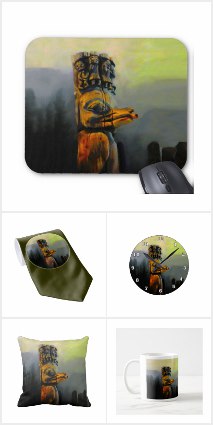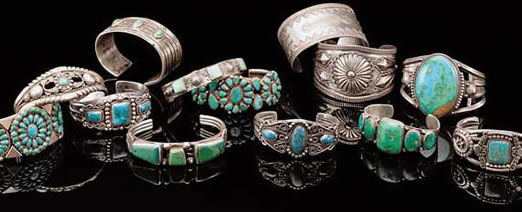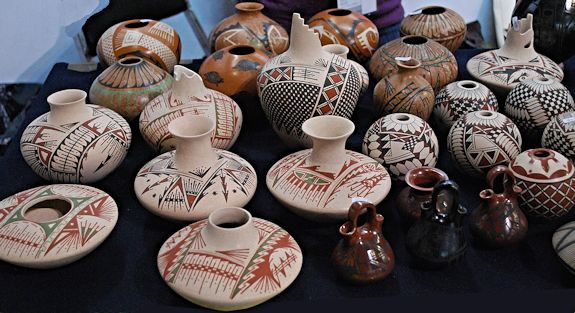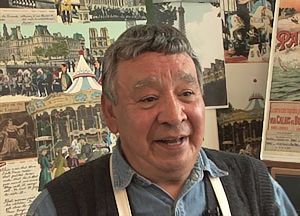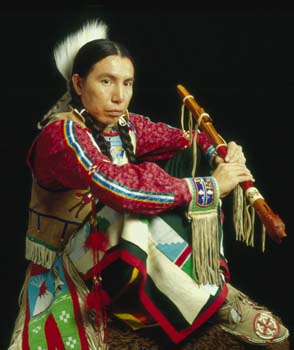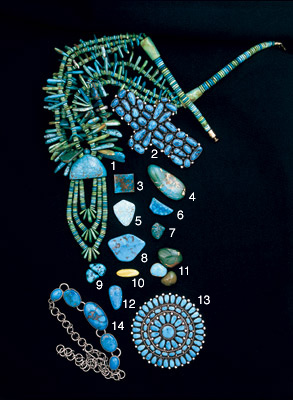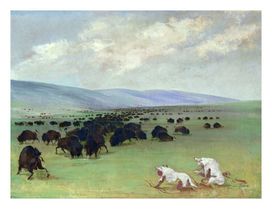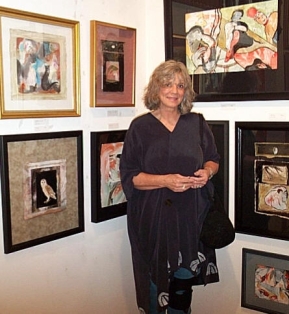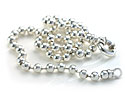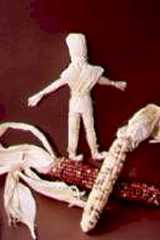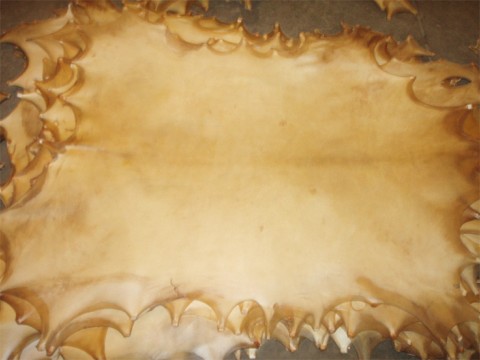Native American bone chokers originally were made from bird legs. They were seldom used as just ornamentation. They were used as physical protection for the throat from a possible knife attack. The jugular vein is in the neck and is lethal if cut. They were also used in conjunction with physical protection as a spiritual protection for the voice. Because most birds are noted for the sounds they make or for their singing quality. The spirit of the bird could be invoked to protect the person’s voice from ailments, jealousy or fatigue.
Arts and Crafts
American Indian Crafts, Customs and Culture
The oldest known art found in North America dates back to approximately 11,000 BC. A bone with the image of a mammoth carved in it was discovered in Florida.
The arts and crafts of the American Indian are among the great traditions of the world. The thread that runs through the folk art of all peoples is a significant one.
Native American Indian Art Types
Pottery (Ceramics) – As with a lot of Indian art, pottery served both a functional and decorative purpose. Traditionally, pottery was used for storing such things as food, water, and valuables such as beads. The Indians also created pots for cooking. However, beyond its functional purposes pottery has been used for artistic expression and painted with beautiful designs and colors.
Baskets – Baskets are one of the oldest art forms of American Indians; some have been discovered dating back nearly eight thousand years. The styles, weaving techniques, and materials vary greatly among the different tribes and American Indian regions.
Masks – Masks were often used in tribal ceremonies and are some of the finest examples of Indian art. Examples are the kachina masks created by the Pueblo Indians. These wooden masks are used in their traditional ceremonies and regarded as living spirits. The Iroquois also create masks for use in ceremonies.
Totem Poles – Perhaps the most striking forms of Indian art are totem poles. These wooden sculptures are often huge some standing up to 40 feet high. They represent the history of a family or clan, represented by their clan or personal totems. The “low man” on a totem pole was actually the most important man in that clan.
Dolls – The most famous Native American dolls are the kachina dolls of the Hopi Indians. These dolls depict the spiritual beings the Hopi worship. Plains tribes made the no face doll as a toy for children. Southwestern tribes make ceramic storyteller dolls. Collectors also collect baby dolls in native American style clothing.
Paintings – Indians have traditionally painted numerous items such as pottery, tipis, clothing, shields, and cave walls. The Navajo tribe’s sand paintings, used in their religious ceremonies, are an excellent example of American Indian painting.
Jewelry – Native American jewelry was worn as adornment and sometimes for protection. Materials used to create jewelry included materials like turquoise, copper, bone, shells, teeth, claws and stone. The famous silver jewelry of the Navajo, Hopi, and other Pueblos is a fairly recent invention developed specifically for the tourist trade. The different tribes have different customs in regards to who made and wore jewelry. For example in the Navajo tribe it was usually the men who made jewelry.
Beadwork – Numerous American Indian tribes create beautiful beadwork, perhaps the best know are those of the Great Plains Indians. Native Americans originally used natural materials for their beads carved by hand such as nuts,shells, turquoise, wood, animal bones, animal horns, and animal teeth. Before Europeans started trading with the Indians and glass beads became available, porcupine quillwork and appliques were common. Beadwork with tiny seed beads largely replaced those earlier forms of decoration.
Ceremonial Objects & Tools – Items used for personal protection or in ceremonies, such as the regalia for pow wow dances, medicine bags, dance sticks, coup sticks, spirit chasers, trail markers, talking sticks, and dream catchers, or tools such as bow & arrows, tomahawks, painted parfletches, and knives, are popular with collectors for use as home décor focus points.
Rugs – The Navajo, as well as some of the Pueblo tribes, are famous for their hand woven rugs..
Not only the objects themselves, but the ideas and emotions that arise from the making and studying of these objects – from holding them, touching them, to passing on the stories behind their creation, give them value.
These ideas and emotions fulfill endless human needs – to connect to the raw materials of the earth, to respect and honor ancestral tradition, and to experience the continuity of life and the spirit. We must understand the legacy of what native american crafts and art stood for and are – – an all-encompassing expression of the best that is human.
General Facts about Totem Poles
22 ViewsOn this page is a list interesting facts about totem poles including where the Indian tribes that made them were, why they sculpted totem poles, how they made them, and what materials they used.
American Indian Baskets
22 ViewsFrom ancient times to the present, Native Americans have created baskets. In fact, basket weaving is one of the oldest crafts developed by man.
Native American Indian baskets range from very simple to elaborate and colorful works of art that took great skill to make. This artwork often involves secret techniques that have been passed down from generation to generation among Native American Indian mothers and daughters.
It is not uncommon for a well-crafted basket to contain over one hundred thousand stitches!
The Shaman’s Rattle
26 ViewsThe shaman’s rattle is a most sacred instrument. The rattle is believed to embody the sacred forces of the cosmos through its sounds, structural features, contents, and connection to the spirit world. The gourd rattle is described as the sound of Creation. The creation stories tell of the first sound, a shimmering sound, which went out in all directions; this was the sound of “the Creator’s thoughts.”
Silver is 99.9% pure elemental silver. Sterling Silver is 92.5% silver and 7.5% other metals, usually copper. But what is coin silver, you ask? We are about to find out.
Silver jewelry can be created many ways. Pure silver is generally too soft for jewelry making, so it is combined (alloyed) with other metals. All the terms used to describe the various creation processes can be confusing. Here is a guide to sort it all out.
Mata Ortiz Casa Grande Pottery
22 ViewsJuan Quezada was only a boy of 12 when he met his destiny to to bring the art world a style of pottery that had been lost for thousands of years. On journeys to the mountains to collect firewood, he became curious about the beautiful pottery shards he would find strewn on the ground at what is now known as the ancient Casa Grande ruins.
Beauty and Balance in Turquoise
22 ViewsOne look at the elaborate turquoise bracelets, engraved silver belt buckles and ornate squash blossom necklaces featured in “Glittering World: Navajo Jewelry of the Yazzie Family,” and it’s clear that by bypassing accounting, Mr. Yazzie is giving the Navajo nation a much richer gift. The exhibition until early 2016 shows about 330 pieces of jewelry made by 15 members of the Yazzie family, with a focus on work by Lee and his younger brother Raymond.
Arthur Amiotte, Oglala Lakota Artist
22 ViewsArthur Amiotte (Wanblí Ta Hócoka Washté or Good Eagle Center) is a native American artist (American painter, collage artist, educator, and author) who was born on the Pine Ridge Reservation in 1942 and raised between the Reservation and Custer, South Dakota. He is a member of the Oglala Lakota Oyate.
Bryan Akipa, a member of the Sisseton Wahpeton Dakota Nation, is a self-taught flute maker, flute player and traditional woodcarver.
Native American Talking Sticks
23 Views
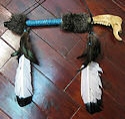 |
| Deer Jaw Talking Stick |
Talking sticks were used in tribal councils and public meetings to maintain order. Whoever had the stick had the floor, and no one else was allowed to speak until the speaker passed the stick, indicating he had finished what he wanted to stay.
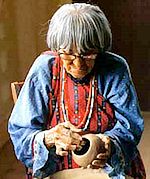 Maria Montoya Poveka Martinez (c 1881 to 1887-1980) is one of the native american pottery masters and probably the most famous of all pueblo potters. She and her husband, Julian, discovered in 1918 how to produce the now-famous black-on-black pottery, and they spent the remainder of their careers perfecting and producing it for museums and collectors worldwide.
Maria Montoya Poveka Martinez (c 1881 to 1887-1980) is one of the native american pottery masters and probably the most famous of all pueblo potters. She and her husband, Julian, discovered in 1918 how to produce the now-famous black-on-black pottery, and they spent the remainder of their careers perfecting and producing it for museums and collectors worldwide.
Much of the vitality of contemporary native pottery stems from her inspiration and inovations.
Frank S. Mullenberg is a new Crow artist in our gallery. His art prints are limited editions of 100. Check out Frank’s native american art.
The most popular jewelry styles from the Southwest are made by the Navajo, Hopi, Zuni and Santo Domingo tribes. While individual artists may make jewelry in a style usually associated with a particular tribe that may not be their own, these are the general, most common differences in the jewelry styles created by these Southwest tribes.
AUTHOR: Jody Rave Lee of the Missoulian When the nation’s premier woolen company asked artist Jesse Henderson todesign a Pendleton blanket, he took it seriously. “I was trying to be sensitive to my people,” said Henderson, aChippewa-Cree from the Rocky Boy’s Reservation in northern Montana. “It’snot just another pretty blanket. I set out to show […]
Indian Fetishes
22 ViewsIndian fetishes are Southwest tribal miniature carvings that some say are imbued with spirit forces.Fetishes are hand-carved objects, which represent the spirits of animals or the forces of nature. From the earliest times in North America, the Indians have used fetishes in an effort to master the arbitrary and unpredictable forces beyond their control. The earliest fetishes are called Ahlashiwe or stone ancients by the Zunis. They were naturally formed stones that seemed to resemble people or animals, sometimes made more realistic with the features accentuated by a carver.
Turquoise, the fallen Sky stone
22 ViewsTurquoise, the “fallen skystone”, “gem of the centuries”, is indigenous to the Americas, Egypt, ancient
Persia (Iran), Tibet and China. Throughout human history, the turquoise stone has been revered and admired for its beauty and reputed spiritual life-enhancing qualities. Native American Turquoise Jewelry is still extremely popular today.
Indian Trade Blankets
22 ViewsWhether woven by a Native American or mass-produced by American woolen mills on a Jacquard loom, the blanket is a constant of Native American life and it is inextricably tied to the tradition of trade in the Southwest. To this day, the rituals tied to blankets are part of Indian life from birth to death: […]
The Indian Trade Blanket
22 ViewsWhether woven by a Native American or mass-produced by American woolen mills on a Jacquard loom, the blanket is a constant of Native American life and it is inextricably tied to the tradition of trade in the Southwest.
As told to us by our elders, these fans are quite significant to the Native Americans. They are used in the Native American Church to sing and to pray with. They are also used in Pow Wows to dance with.
This story is told according to the teachings of Navajo elders. There are many others told by other tribes, but this is the way my particular fans are put together.The legends told to us about these fans are as follows:
How to weave a cattail mat
22 ViewsSewn cattail mats were often used as exterior coverings of wigwams. Most full-size sewn cattail mats measured five to six feet wide and 10 feet long. It would take half a dozen or more mats to cover a wigwam.
Gary Ampel is a Wildlife artist who also captures on canvas the majesty of the American Plains Indians. He paints in a realistic style, working in oils and acrylics. Gary Ampel has been a professional artist and portrait painter for the past thirty eight years.
Famed Navajo artist R.C. Gorman is dead at the age of 74.
Prized for their “down to earth” beauty and spiritual renewal, fetishes have long been an important part of Native American culture.
When a fetish maker prays over his created work, a mystical power is believed to be released which can assist him in finding a solution to his present problems.
Quah Ah (White Coral Beads) was the first Pueblo woman artist to throw off the traditional restrictions that were usually imposed upon women tin Pueblo culture, and paint just as freely as her esthetic sensitivity directed. She was born Tonita Vigil, at San Ildefonso Peublo, New Mexico on June 13, 1895, the daughter of Ascension […]
Make your own paints
22 ViewsMake your own paints..KEYWORDS: recipe for finger paint kids projects kids crafts homemade paint Here are a couple recipes for making your own homemade finger paints. Salt and Flour Finger Paints Ingredients: 2 cup flour 2 tsp. salt 3 cup cold water 2 cup hot water Food coloring Directions: Add the salt to the flour […]
Hopi silver jewelry… KEYWORDS: hopi silver jewelry, sterling silver jewelry, modern silver jewelry
Hopi silver jewelry is a modern craft that has existed as an art form only since about 1890. After World War II, returning Hopi servicemen were trained at a silversmithing school founded under the G.I. bill.
Modern Hopi potters
22 ViewsHopi potters draw on a tradition going back centuries. The ancestors of the Hopi made gray utility ware as long ago as A.D. 700. The ancient potters developed black on white styles, black on red, and finally polychromes. In the late 1800s, outsiders began to appreciate the artistry of Hopi potters. This new demand sparked what has been called the revival period for Hopi pottery.
Early history of Hopi pottery
22 ViewsThe Hopi call their ancestors, Hisatsinom, “People of Long Ago.” The public and most anthropologists refer to these people as the “Anasazi,” a word that has become popular in the general literature.
Early Hisatsinom are called the Basketmaker people. The Basketmakers were a hunting and gathering people who became increasingly sedentary as their reliance on agriculture increased. As early as A.D. 700, the Basketmaker people began making plain pottery.
Hopi Basketry techniques and uses
22 ViewsHopi Basketry techniques and uses.. KEYWORDS: hopi basketry uses for hopi baskets plaited baskets wicker baskets coiled baskets rabbit brush basket sumac basket coiled baskets second mesa third mesa hopi trays hopi plaques hopi wedding traditions hopi bowls burden basket hopi peach basket
Three basic techniques, plaiting, wicker, and coiling, are employed by Hopi basket weavers. More than one method is sometimes used in making a single basket, providing an array of visual effects.
Frederick Remington Biography – artist, illustrator, sculptor, painter…The works of 19th-century American sculptor and illustrator Frederic Remington (1861-1909) recall the rough-hewn frontier life of the American West.
What is a Limited Edition Fine Art Print?.. KEYWORDS: native american limited edition fine art prints what is a limited edition fine art print A limited edition print is an original image limited to a predetermined print quantity. The edition is often signed by the artist and individual prints are always numbered. The numbers on […]
Native American Jewelry Art
22 ViewsTotems to Turquoise: Native North American Jewelry Arts of the Northwest and Southwest.. KEYWORDS: native american jewelry art of the northwest art of the southwest navajo jewelry hopi jewelry zuni jewelry pueblo jewelry haida jewelry tlingit jewelry salish jewelry American Museum of Natural History exhibit Native American jewelry for centuries has represented more than simply […]
Beading Loom Kit
22 ViewsBeading Loom Kit.. Shop for native american themed crafts. Make woven bead strips with this beading loom kit bead loom for making bead strips. This catalog page contains a beading loom kit.
This week’s featured Artist of the Week is the renown Carol Grigg, who is famous for her stylized horses and native american art.
Carol Grigg grew up and still lives in Oregon. Grigg draws inspiration from her Cherokee Indian heritage, nature, and primitive art. She works in multiple media: watercolor, oil, inks, lithography, collage, clay, music, and poetry.
Legend of the Talking Feather
22 ViewsMany winters ago the people received a gift called the talking feather. I will share with you the story of how this came to pass.When the call came to the young mothers in the village to take their baskets and gather the fruit and berries, the old grandmothers, whose legs had lost the fast walk and sure foot of the doe, were left to care for the young children. The mothers honored the grandmothers by giving them this responsibility on those days.
KEYWORDS: soft leather crafts Indian culture beadwork native american craft work leather artist teach youngsters I feel I have somthing to offer, in spite of how I was treated, for what half of me is. I’m willing to teach any what I know, especially youngsters. From what I’ve been told from other artists as of […]
What is sterling silver, anyway?
23 ViewsKEYWORDS: what is sterling silver jewelry advantages of sterling silver disadvantages of sterling silver care of sterling silver jewelry Sterling silver is the standard for beautiful high-quality silver jewelry. It’s 92.5% pure silver, mixed with alloys to add strength and durability. And it won’t wear down, as silver plating can. This guide will help you […]
SAN JUAN ISLAND, WASH. – As Doug Bison sculpts in the quiet of his home studio on San Juan Island, in Washington state’s Puget Sound, the thoughts that inspire him are of a place long ago and far away. It’s a painful place – memories his grandfather locked away to be diluted by the passing […]
How to make a corn husk doll
26 ViewsKEYWORDS: how to make a corn husk doll kid’s craft project native american doll cornhusk doll easy crafts for kids thanksgiving crafts Thanksgiving craft projects
Age Appropriate: K-6
What you’ll need to make a cornhusk doll:
9-12 pieces of green corn husk
String or twine
Decorative pieces
Scissors
Bowl of water
Glue
Use green corn husks
Marie Buchfink Fine Art Prints
22 ViewsMarie Buchfink was born in Muskegon, Michigan. Ms. Buchfink graduated from Michigan State University with a B.A. Degree in Fine Arts and Art History.
Zuni tradition lives in fetishes
22 ViewsKEYWORDS: Zuni fetishes sacred and powerful fetish animal carvings Zuni tribe Native Americans bear medicine snake medicine horny toad fetish frog medicine hunting fetish coyote fetishes Lasiloo-Jim turquoise fetish Zuni Indian Reservation Gallup NM fetish worship AUTHOR: Valerie GrittonStaff Writer, The Daily Times FARMINGTON, N.M. — The Zuni consider the things least understood and most […]
How to make a quality hand drum
22 ViewsKeywords: how to make a drum cheap american indian drums hand drum powwow drum pow wow drums make a drum indian musical instruments native american crafts rawhide drum instructions drum hoop cedar drums
The drum has been significant to all native nations for thousands of years. It is a sacred item. The drum is man’s connection to the earth, and symbolizes the life force of creation. For centuries the drum has been used to amplify the voice and synchronize the heart beat of man to the natural rhythms of the earth.
In this article, you will learn how to make your own drum for little or no money.
How to make rawhide
22 ViewsMaking your own rawhide is much easier than tanning a hide for the novice, and quite inexpensive. Here is how it’s done.
Rudolph “R.C.” Gorman, Navajo artist and sculptor
(July 26, 1931 – November 3, 2005)
Navajo artist R.C. Gorman was considered by many to be the premiere Indian artist. A man of today in every sense, R.C. Gorman art reflects the racial memory and experience of an ancient people that remains timeless and universal.
Michael Coleman (1941-?) Biography
22 ViewsBorn and continuing to live in Provo, Utah, Michael Coleman is a prominent Southwestern landscape painter in a traditional style and is much influenced by 19th-century painters Henry Farny, Thomas Moran and George Inness.
Frederic Sackrider Remington filled his school notebooks full of sketches, often depicting Old West characters and equestrian figures. Remington’s fondness for horses also materialized at an early age. As a boy, Remington was an accomplished rider, a skill imparted by his father who had been a cavalry officer during the Civil War. In 1872, the Remington […]
Scholars have long debated the origin of wampum development and use. Anthropologist Lynn Ceci theorized that marine shell beads made their appearance as early as 2500 BC, but the finished product of tubular wampum did not appear until about 200-1510 AD.
Though some tribal members say they see no problem with the practice, others regard the marketing of dream catchers as another example of their culture being picked apart.
What is a Serigraph?
22 ViewsDo you know what makes a serigraph so special? Find out in this article.
- 1
- 2
